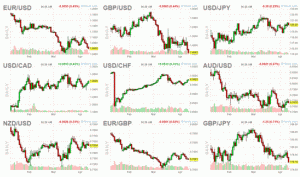- The US Dollar in calm regime on Monday, though still at elevated levels near last week’s high.
- Tensions in the Middle East keep lingering while traders gear up for the Fed Minutes and US CPI release later this week.
- The US Dollar Index trades above 102.00, with traders fretting over whether to send the DXY towards 103.00.
The US Dollar (USD) is having a very soft start of the week, going sideways on Monday, with the US Dollar Index (DXY), which tracks the Greenback’s value against six major currencies, hovering around 102.50. While traders are bracing for the US Federal Reserve (Fed) Minutes and the US Consumer Price Index (CPI) release for September later this week, no less than four Fed speakers are lined up to guide markets toward November’s rate decision on Monday.
The economic calendar is light on Monday, with only the Consumer Credit Change for August on the docket in terms of numbers. Later this week, the US CPI on Thursday will be the main driver for the US Dollar. Markets are still assessing whether the US economy is in a soft landing, a Goldilocks scenario, or rather in a recession outlook.
Daily digest market movers: Israel considering options
- There is no agreement or green light from US President Joe Biden on the question from Israel to attack Iranian oil fields. The Biden administration did not deliver a firm no, but on Friday, President Biden told Bloomberg that he would be thinking about alternatives other than striking oil fields.
- Consumer Credit Change for August is due at 19:00 GMT, with expectations to see a drop to $12 billion from $25.45 billion in July.
- Four Fed speakers are lined up on Monday:
- At 17:00 GMT, Federal Reserve Governor Michelle Bowman participates in a fireside chat about banking regulation at the Independent Bankers Association of Texas (IBAT) annual convention in San Antonio, Texas.
- Near 17:50 GMT, Federal Reserve Bank of Minneapolis President Neel Kashkari participates in a Q&A and moderated discussion at the Bank Holding Company Association’s (BHCA) Fall Seminar in Edina, MN.
- At 22:00 GMT, Federal Reserve Bank of Atlanta President Raphael Bostic moderates a conversation about the business of professional spots as part of the Atlanta Fed’s Leading Voice series.
- Closing off the Monday, near 22:30 GMT, Federal Reserve Bank of St. Louis President Alberto Musalem delivers a speech about the US economy and monetary policy in a Money Marketeers event at New York University.
- European markets are struggling on Monday, with equity indices dipping lower, while US futures are looking even more sluggish with bigger losses on the day, around 0.50% on average.
- The CME Fedwatch Tool shows a 93.1% chance of a 25 basis point (bps) interest rate cut at the next Fed meeting on November 7, while 6.9% is pricing in no rate cut. Chances for a 50 bps rate cut have been fully priced out now.
- The US 10-year benchmark rate trades at 3.99%, a 30-day high, and flirting with a break above 4.00%.
US Dollar Index Technical Analysis: Fed futures fully repriced
The US Dollar Index (DXY) has sprinted higher at a speed that brings Usain Bolt instantly to mind. With a 50 bps rate cut fully priced out and chances for no rate cut starting to grow in possibility, the pendulum may have swung a bit too far and too quickly. Expect the DXY set to ease a touch and look for support before the next directional move.
The psychological level of 103.00 is the first big number to tackle on the upside. Further up, the chart identifies 103.18 as the very final level for this week. Once above there, a very choppy area emerges with the 100-day Simple Moving Average (SMA) at 103.34, the 200-day SMA at 103.76, and the pivotal 103.99-104.00 levels in play.
On the downside, the 55-day SMA at 102.03 is the first line of defence, backed by the 102.00 round figure and the pivotal 101.90 level as support to catch any bearish pressure and trigger a bounce. If that level does not work out, 100.62 also acts as support. Further down, a test of the year-to-date low of 100.16 should take place before more downside. Finally, and that means giving up the big 100.00 level, the July 14, 2023, low at 99.58 comes into play.
US Dollar Index: Daily Chart
Fed FAQs
Monetary policy in the US is shaped by the Federal Reserve (Fed). The Fed has two mandates: to achieve price stability and foster full employment. Its primary tool to achieve these goals is by adjusting interest rates. When prices are rising too quickly and inflation is above the Fed’s 2% target, it raises interest rates, increasing borrowing costs throughout the economy. This results in a stronger US Dollar (USD) as it makes the US a more attractive place for international investors to park their money. When inflation falls below 2% or the Unemployment Rate is too high, the Fed may lower interest rates to encourage borrowing, which weighs on the Greenback.
The Federal Reserve (Fed) holds eight policy meetings a year, where the Federal Open Market Committee (FOMC) assesses economic conditions and makes monetary policy decisions. The FOMC is attended by twelve Fed officials – the seven members of the Board of Governors, the president of the Federal Reserve Bank of New York, and four of the remaining eleven regional Reserve Bank presidents, who serve one-year terms on a rotating basis.
In extreme situations, the Federal Reserve may resort to a policy named Quantitative Easing (QE). QE is the process by which the Fed substantially increases the flow of credit in a stuck financial system. It is a non-standard policy measure used during crises or when inflation is extremely low. It was the Fed’s weapon of choice during the Great Financial Crisis in 2008. It involves the Fed printing more Dollars and using them to buy high grade bonds from financial institutions. QE usually weakens the US Dollar.
Quantitative tightening (QT) is the reverse process of QE, whereby the Federal Reserve stops buying bonds from financial institutions and does not reinvest the principal from the bonds it holds maturing, to purchase new bonds. It is usually positive for the value of the US Dollar.




